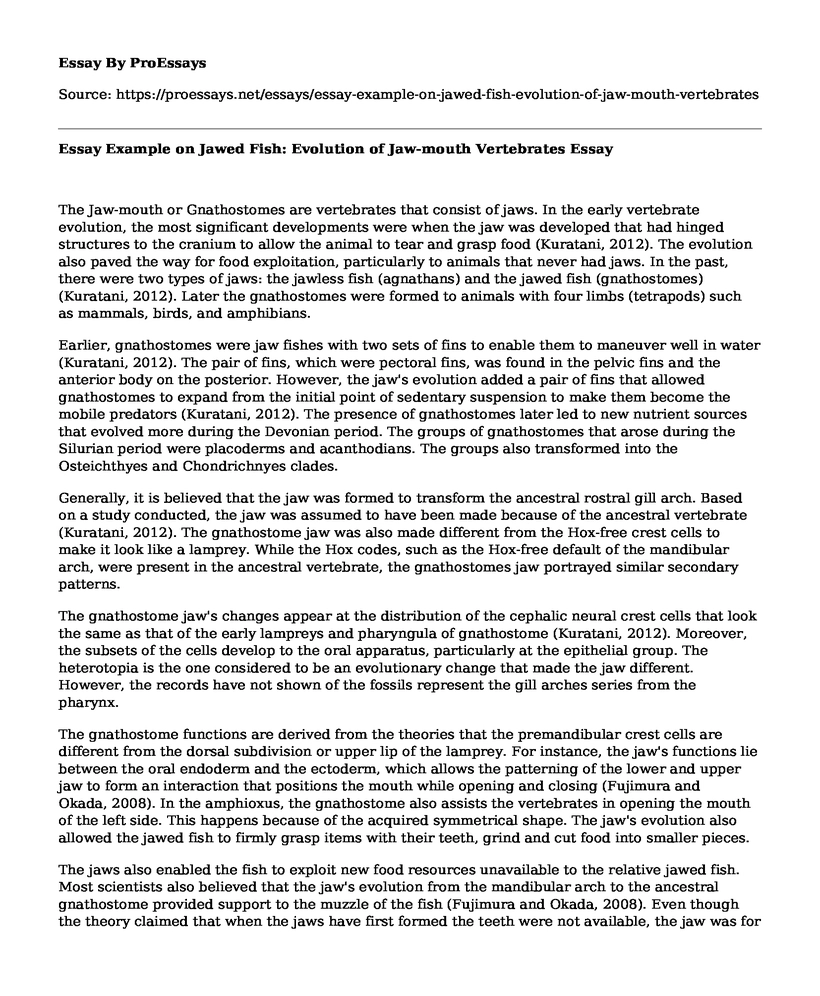The Jaw-mouth or Gnathostomes are vertebrates that consist of jaws. In the early vertebrate evolution, the most significant developments were when the jaw was developed that had hinged structures to the cranium to allow the animal to tear and grasp food (Kuratani, 2012). The evolution also paved the way for food exploitation, particularly to animals that never had jaws. In the past, there were two types of jaws: the jawless fish (agnathans) and the jawed fish (gnathostomes) (Kuratani, 2012). Later the gnathostomes were formed to animals with four limbs (tetrapods) such as mammals, birds, and amphibians.
Earlier, gnathostomes were jaw fishes with two sets of fins to enable them to maneuver well in water (Kuratani, 2012). The pair of fins, which were pectoral fins, was found in the pelvic fins and the anterior body on the posterior. However, the jaw's evolution added a pair of fins that allowed gnathostomes to expand from the initial point of sedentary suspension to make them become the mobile predators (Kuratani, 2012). The presence of gnathostomes later led to new nutrient sources that evolved more during the Devonian period. The groups of gnathostomes that arose during the Silurian period were placoderms and acanthodians. The groups also transformed into the Osteichthyes and Chondrichnyes clades.
Generally, it is believed that the jaw was formed to transform the ancestral rostral gill arch. Based on a study conducted, the jaw was assumed to have been made because of the ancestral vertebrate (Kuratani, 2012). The gnathostome jaw was also made different from the Hox-free crest cells to make it look like a lamprey. While the Hox codes, such as the Hox-free default of the mandibular arch, were present in the ancestral vertebrate, the gnathostomes jaw portrayed similar secondary patterns.
The gnathostome jaw's changes appear at the distribution of the cephalic neural crest cells that look the same as that of the early lampreys and pharyngula of gnathostome (Kuratani, 2012). Moreover, the subsets of the cells develop to the oral apparatus, particularly at the epithelial group. The heterotopia is the one considered to be an evolutionary change that made the jaw different. However, the records have not shown of the fossils represent the gill arches series from the pharynx.
The gnathostome functions are derived from the theories that the premandibular crest cells are different from the dorsal subdivision or upper lip of the lamprey. For instance, the jaw's functions lie between the oral endoderm and the ectoderm, which allows the patterning of the lower and upper jaw to form an interaction that positions the mouth while opening and closing (Fujimura and Okada, 2008). In the amphioxus, the gnathostome also assists the vertebrates in opening the mouth of the left side. This happens because of the acquired symmetrical shape. The jaw's evolution also allowed the jawed fish to firmly grasp items with their teeth, grind and cut food into smaller pieces.
The jaws also enabled the fish to exploit new food resources unavailable to the relative jawed fish. Most scientists also believed that the jaw's evolution from the mandibular arch to the ancestral gnathostome provided support to the muzzle of the fish (Fujimura and Okada, 2008). Even though the theory claimed that when the jaws have first formed the teeth were not available, the jaw was for ventilation and not for the prey to capture and process food (Fujimura and Okada, 2008). This is the reason why there is a difference in the mouth positions. This is because of the cranial ectoderm formed between the gnathostome and lamprey about the jaw evolution.
References
Fujimura, K., & Okada, N. (2008). Bone development in the jaw of Nile tilapia Oreochromis niloticus (Pisces: Cichlidae). Development, Growth & Differentiation, 50(5), 339-355. https://doi.org/10.1111/j.1440-169x.2008.01032.x
Kuratani, S. (2012). Evolution of the vertebrate jaw from developmental perspectives. Evolution & Development, 14(1), 76-92. https://doi.org/10.1111/j.1525-142x.2011.00523.x
Cite this page
Essay Example on Jawed Fish: Evolution of Jaw-mouth Vertebrates. (2023, Aug 29). Retrieved from https://proessays.net/essays/essay-example-on-jawed-fish-evolution-of-jaw-mouth-vertebrates
If you are the original author of this essay and no longer wish to have it published on the ProEssays website, please click below to request its removal:
- Stored Samples and Consent for Future Use in Genetics
- Speech Example on Harvest Time: Animal Slaughter in Barbara Kingsolver's Animal, Vegetable, Miracle
- Biophilic Design: Creating a Connection to Nature in Buildings - Essay Sample
- Essay Sample on Mountain Formation: Orogeny, Volcanism & Tectonics
- Birds Show Cognitive Attributes on Par With Mammals - Essay Sample
- Animal Testing: Unethical and Inhumane Practice - Essay Sample
- Essay Example on 82% Decline in Wild Mammal Biomass: What Endangers Species?







